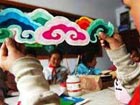| Videos | • Latest |
|
• Feature | • Sports | • Your Videos |
Tibetan Regong art gets gov't funding

 0 Comment(s)
0 Comment(s) Print
Print E-mail
CNTV, November 23, 2011
E-mail
CNTV, November 23, 2011
Called "the flower on the Tibetan Plateau, Regong art is an important part of Tibetan Buddhism with a history of more than 700 years. It has long been popular with ethnic TIbetan and Tu folk artists in Qinghai Province, Sichuan Province and many other areas.
Now, let's head to Tongren County of Qinghai Province to see how this artistic style is being preserved.
Regong art is an ancient style that includes paintings, murals, thangka, barbola, and sculptures, and was listed with the first batch of China's national-level intangible cultural heritage items.
One national inheritor of Regong art is Niang Ben. He opened the Regong Art Academy in 2006 in order to inherit, showcase and sell the works. The academy is expanding into vocational schools to teach as many as 500 students.
Niang Ben received his training from art master Xia Wu. For years he wanted to fulfill his teacher's last wish to open a school, even though he lacked the money. To make the dream come true, he sold three of his own treasured paintings.
Niang Ben said, "As an artist and inheritor, I must well Inherit this art and spread these skills."
In 2009, Niang Ben became a national representative of Regong art and received one million yuan from the government. Now his art school showcases art by over 600 painters and also sells them overseas. In the same year, the school adopted 23 children from the Children's Welfare Office and is teaching them Regong art.
Li Xianjia, student of Regong Art School, said, "I love painting very much. Also, the teachers take good care of us here."
One of the focuses of the recent 6th Plenary Session of the 17th Party Congress of the CPC was to construct an infrastructure that promotes Chinese culture and protects intangible cultural heritage. Under the new policy, funds are provided to inheritors who conduct required activities and recruit apprentices to inherit traditional culture.






Go to Forum >>0 Comment(s)